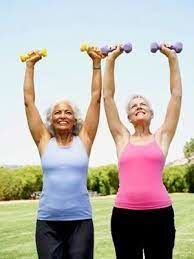What is menopause?
Menopause is the period of time after the last menstrual cycle, signifying the end of a woman's reproductive period. Typically, menopause occurs between 40-60 years of age and can last between 7-12 years.
During this time, women experience fluctuations in hormone production, leading to a decrease of estrogen, which affects multiple systems of the body. Common symptoms include:
- Hot flushes
- Fat mass gain
- Muscle loss
- Fatigue
- Anxiety and mood changes
- Sleeping issues
- Joint pain
- Decreased libido and sexual dysfunction
These can have a major impact on the lifestyle, well-being and behaviour of women experiencing them. In addition to this, menopausal women are at risk of developing serious health conditions such as:
- Osteoporosis
- Diabetes
- and Coronary Artery Disease
Whose symptoms are often "silent" and are only found through regular screening.
How does exercise help?
Exercise is becoming one of the go-to alternative treatments to Hormone Replacement Therapy (HRT) for managing symptoms and reducing the health impacts of menopause. Studies have shown that even pairing HRT and strength training can increase the effectiveness of therapy.
Hot flushes
A study by Berin et al (2016) showed that 3 months of strength training, 2x a week halved (44%) hot flushes when compared to women who were sedentary. Strength training releases endorphins that alter the thermoregulatory centre in the brain, to reduce the frequency of symptoms. Low-intensity exercise (e.g. walking) was less effective at reducing hot flush symptoms than moderate-high intensity exercise - so ladies make sure you're working hard!
Lean Muscle, Fat Loss and Weight Control
Strength training, at least 2 times a week, has shown to increase muscle strength in menopausal women, which preserves tissue health and improves exercise tolerance. Muscle strength and muscle tissue both decline with age, so strength training helps to prevent this.
By increasing your muscle composition, you are also increasing the calories you burn while resting (basal metabolic rate), as 1g of muscle burns more calories than 1g of fat.
You can notice significant changes in body composition and weight control after 8 weeks (2 months) of consistent strength training, although training for greater than 6 months yields better effects.
Higher intensity exercise (e.g. heavy strength training) is better than lower intensity exercise (yoga, walking) in facilitating fat loss and decreasing muscle loss.
Prevention of osteoporosis
Strength training is the gold-standard treatment for conditions such as osteoporosis and osteopenia (bone brittleness). Strength training stimulates the production of better bone, tissues and tendons, which slows the rate at which the body breaks down bone, which occurs as part of the aging process. Bone density decreases with age, and accelerates with low activity or periods of inactivity. This increases the risk of sustaining a bone fracture, which is common for many post-menopausal women.
Performing 2x weekly sessions of high-intensity strength training and weight bearing (i.e. standing exercises) improved bone density scores compared to those who only performed a low intensity home exercise program (e.g. walking).
Improving mood and quality of life
Exercise is a known treatment for depression, anxiety and other mental health conditions. Exercise stimulates a big release of antidepressant hormones (e.g. serotonin and dopamine) which have positive effects on mood and well-being.
How do I get into strength training?
Find strength exercises that you like and do them with people you like! We usually recommend choosing 6 or so exercises that target all the major muscle groups (i.e. compound exercises like: squats, deadlifts, press ups) and add weights! Of course it is important to know your limits and abilities, and it is always better to start off with smaller weights and always seek guidance before performing a new movement.
If you are uncertain, check in with your physio who can help provide some guidance. Remember, lifting heavy weights while supervised is safe and recommended for you.
The key thing is that you are working "harder" (i.e. 6/10 or 7/10 effort) and are performing 3 sets of 10 (or 8-12 reps). It is very important to have a rest break (60-90secs) between each exercise.
You can even join a strength class or pilates class run by us at Gold Coast Sports and Spinal, where we incorporate a combination of pilates and functional strengthening to address your body's needs.

